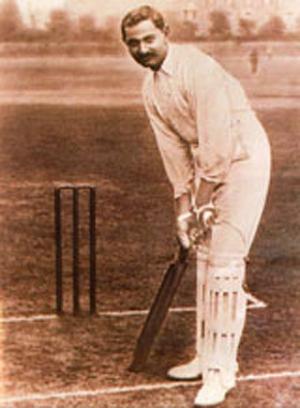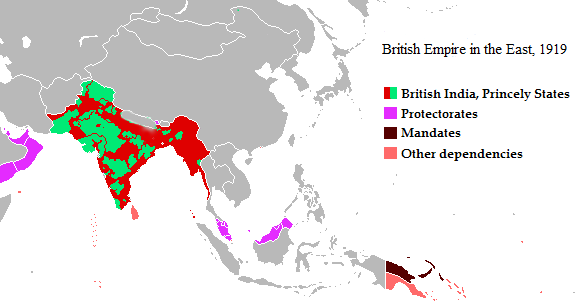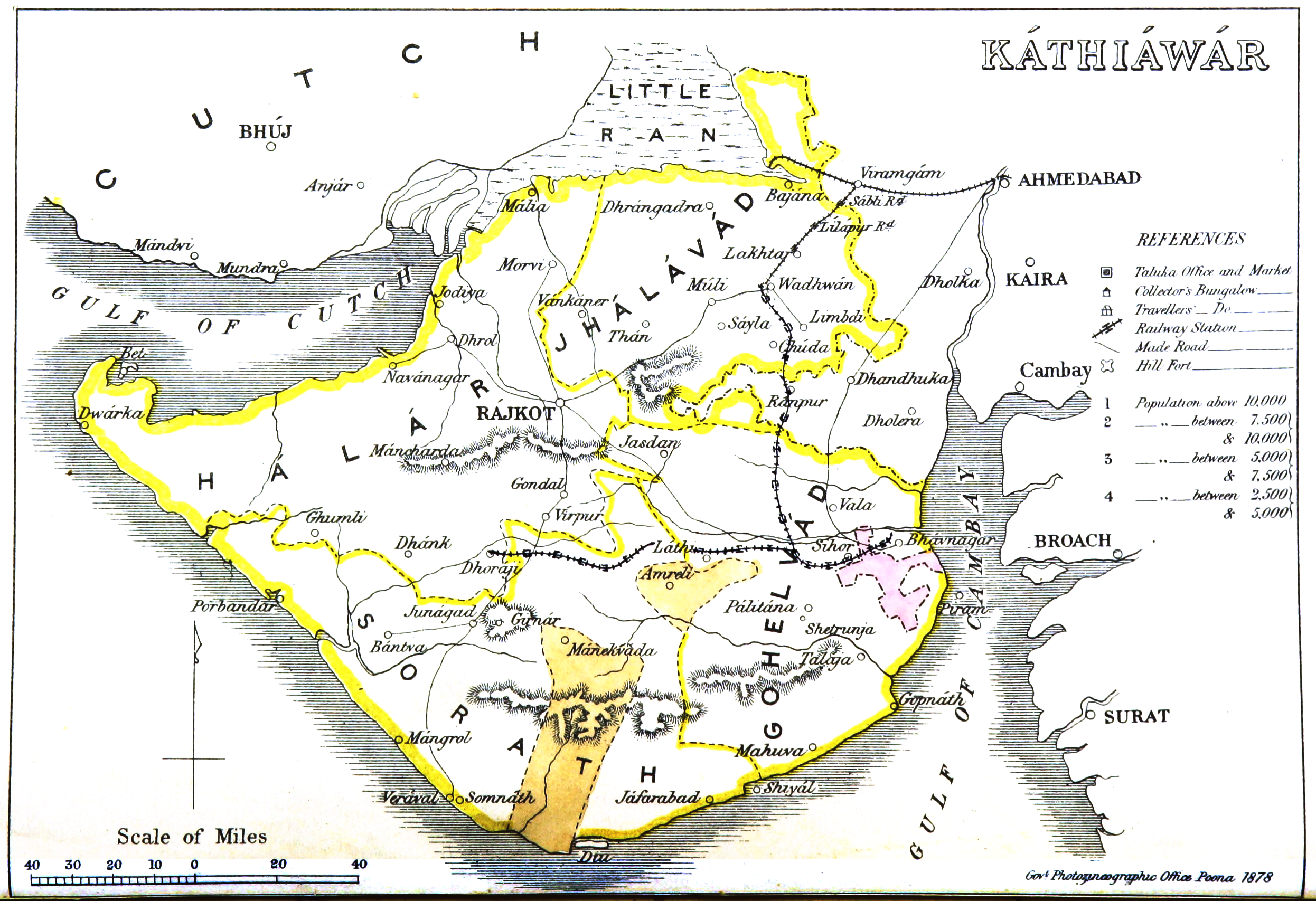|
Lakhajirajsinhji II Bavajirajsinhji, 12th Thakore Saheb Of Rajkot
Lakhajirajsinhji II (17 December 1885 – 2 February 1930) was the ruler of the Indian princely state of Rajkot from April 1890 until his death, holding the title ''Thakore Saheb''. He came to the throne at the age of four, following the death of his father and his three older brothers. However, he did not govern in his own right until the age of 21, in 1907. Lakhajirajsinhji became one of the most progressive princely state rulers, introducing some of the first democratic institutions in India. He also fostered a culture of openness and intellectualism that laid the foundation for Rajkot as a centre of the Indian independence movement. Early life and family Lakhajirajsinhji was born to a Rajput family in Rajkot on 17 December 1885. His father, Bavajirajsinhji, had succeeded to the throne of Rajkot in 1862, aged six, upon the death of his own father, Meramanji IV. Rajkot State, comprising various territories in the interior of Gujarat's Kathiawar peninsula, had been founde ... [...More Info...] [...Related Items...] OR: [Wikipedia] [Google] [Baidu] |
Pargana
Pargana ( bn, পরগনা, , hi, परगना, ur, پرگنہ) or parganah, also spelt pergunnah during the time of the Sultanate period, Mughal times and British Raj, is a former administrative unit of the Indian subcontinent and each ''Parganas'' may or may not subdivided into some ''pirs''. Those revinue units are used primarily, but not exclusively, by the Muslim kingdoms. After independence the Parganas became equivalent to Block/ Tahsil and Pirs became Grampanchayat. ''Parganas'' were introduced by the Delhi Sultanate. As a revenue unit, a pargana consists of several ''mouzas'', which are the smallest revenue units, consisting of one or more villages and the surrounding countryside. Under the reign of Sher Shah Suri, administration of parganas was strengthened by the addition of other officers, including a ''shiqdar'' (police chief), an ''amin'' or ''munsif'' (an arbitrator who assessed and collected revenue) and a ''karkun'' (record keeper). Mughal era In th ... [...More Info...] [...Related Items...] OR: [Wikipedia] [Google] [Baidu] |
Rani
''Rani'' in Indian Subcontinent and Southeast Asia, sometimes spelled ''Ranee'', is a Hindu/Sanskrit feminine given name. The term is the female form of the term for princely rulers in South and Southeast Asia and applies equally to the wife of a ''Raja'' or ''Rana''. in some cases British-Indian descendants are also tagged with "rani" attached to their firstname. Notable people named Rani * Rani (Pakistani actress) (born December 8, 1946 – died May 27, 1993), Pakistani actress and model * Rani Bhabani (born 1716 – died 1795), Indian philanthropist and zamindar * Rani Chandra (born October 12, 1976), Indian actress and winner of the Miss Kerala pageant * Rani Chatterjee (born November 3, 1984), Indian actress, dancer and presenter * Rani Chitralekha Bhonsle (born February 26, 1941), Indian political and social worker * Rani Gaidinliu (born January 26, 1915 – died February 17, 1993), Indian activist, spiritual and political leader * Rani Hamid (born 1944), Bangladeshi ... [...More Info...] [...Related Items...] OR: [Wikipedia] [Google] [Baidu] |
Rajkumar College, Rajkot
The Rajkumar College (or RKC) in Rajkot, Gujarat is one of the oldest K-12 institutions in India. RKC has a 26-acre (105,000 m²) campus in Rajkot. History The foundation stone of Rajkumar College was laid in 1868. The institution was designed by Colonel Keatinge and was formally opened by the Governor of Bombay, H. B. Sir Seymour Fitzgerald, in 1870. The college was founded for the education of the princely order by the princes and chiefs of Kathiawad for their sons and relations. In 1938, on the initiative of its founding members, the college became a public school (private school in American terms). The college is a founding member of the Indian Public Schools Conference and a member of the Round Square conference of schools, a worldwide association of more than 60 schools that allows students to travel between schools and tour the country or do community service. In 2001 the college opened its doors to girls, in what has been a boys' bastion for over a century. The sc ... [...More Info...] [...Related Items...] OR: [Wikipedia] [Google] [Baidu] |
Salute State
A salute state was a princely state under the British Raj that had been granted a gun salute by the British Crown (as paramount ruler); i.e., the protocolary privilege for its ruler to be greeted—originally by Royal Navy ships, later also on land—with a number of cannon shots, in graduations of two salutes from three to 21, as recognition of the state's relative status. The gun-salute system of recognition was first instituted during the time of the East India Company in the late 18th century and was continued under direct Crown rule from 1858. As with the other princely states, the salute states varied greatly in size and importance. The states of Hyderabad and Jammu and Kashmir, both with a 21-gun salute, were each over 200,000 km2 in size, or slightly larger than the whole of Great Britain; in 1941, Hyderabad had a population of over 16,000,000, comparable to the population of Romania at the time, while Jammu and Kashmir had a population of slightly over 4 million ... [...More Info...] [...Related Items...] OR: [Wikipedia] [Google] [Baidu] |
Kathiawar Agency
The Kathiawar Agency, on the Kathiawar peninsula in the western part of the Indian subcontinent, was a political unit of some 200 small princely states under the suzerainty of the Bombay Presidency of British India. The agency's headquarters were at Rajkot, the town where the Political Agent used to reside. He reported to the Political Department office at Bombay, Bombay Presidency. History The agency was formed in 1822, after the princely states in the area became British protectorates. The region was severely affected by the famine of 1899–1900. Between 1891 and 1901, the population of the states covered by the Agency decreased by 15 per cent, largely due to the results of the famine. On 10 October 1924, the agency was abolished and merged into the Western India States Agency, which had three subdivisions:The Indian Year Book, Volume 11 by Bennett, Coleman & Company, 1924,pp:151–152 * Eastern Kathiawar Agency (from 1926 onwards) * Western Kathiawar Agency (from 19 ... [...More Info...] [...Related Items...] OR: [Wikipedia] [Google] [Baidu] |
Regent
A regent (from Latin : ruling, governing) is a person appointed to govern a state ''pro tempore'' (Latin: 'for the time being') because the monarch is a minor, absent, incapacitated or unable to discharge the powers and duties of the monarchy, or the throne is vacant and the new monarch has not yet been determined. One variation is in the Monarchy of Liechtenstein, where a competent monarch may choose to assign regency to their of-age heir, handing over the majority of their responsibilities to prepare the heir for future succession. The rule of a regent or regents is called a regency. A regent or regency council may be formed ''ad hoc'' or in accordance with a constitutional rule. ''Regent'' is sometimes a formal title granted to a monarch's most trusted advisor or personal assistant. If the regent is holding their position due to their position in the line of succession, the compound term '' prince regent'' is often used; if the regent of a minor is their mother, she would ... [...More Info...] [...Related Items...] OR: [Wikipedia] [Google] [Baidu] |
Paramount Ruler
{{Use American English, date=December 2018 The term paramount ruler, or sometimes paramount king, is a generic description, though occasionally also used as an actual title, for a number of rulers' position in relative terms, as the summit of a feudalistic pyramid of rulers of lesser polities (such as vassal princes) in a given historical and geographical context, often of different ranks, which all recognize the single paramount ruler as their senior, though not necessarily with effectively commanding authority (as in a true empire), but often rather a notion like the Western suzerainty. Whether the term is used where it could apply is essentially a matter of convention, and as the relatively vague, similar definitions overlap, its use may in certain cases coexist with the use of another term as those mentioned in the ''See also'' section. Examples *In the Indian subcontinent, including present Pakistan and Bangladesh, the Muslim Sultans of Delhi, known as Grand Mughals be ... [...More Info...] [...Related Items...] OR: [Wikipedia] [Google] [Baidu] |
Cantonment
A cantonment (, , or ) is a military quarters. In Bangladesh, India and other parts of South Asia, a ''cantonment'' refers to a permanent military station (a term from the colonial-era). In United States military parlance, a cantonment is, essentially, "a permanent residential section (i.e. barrack) of a fort or other military installation," such as Fort Hood. The word ''cantonment'', derived from the French word '' canton'', meaning ''corner'' or ''district'', refers to a temporary military or winter encampment. For example, at the start of the Waterloo campaign in 1815, while the Duke of Wellington's headquarters were in Brussels, most of his Anglo–allied army of 93,000 soldiers were ''cantoned'', or stationed, to the south of Brussels. List of permanent cantonments Afghanistan The former Sherpur Cantonment in Kabul, Afghanistan, which was the site of the Siege of the Sherpur Cantonment (1879) in the Second Anglo-Afghan War (1878–1880), is now maintained as a British Army ... [...More Info...] [...Related Items...] OR: [Wikipedia] [Google] [Baidu] |
British Residents
A resident minister, or resident for short, is a government official required to take up permanent residence in another country. A representative of his government, he officially has diplomatic functions which are often seen as a form of indirect rule. A resident usually heads an administrative area called a residency. "Resident" may also refer to resident spy, the chief of an espionage operations base. Resident ministers This full style occurred commonly as a diplomatic rank for the head of a mission ranking just below envoy, usually reflecting the relatively low status of the states of origin and/or residency, or else difficult relations. On occasion, the resident minister's role could become extremely important, as when in 1806 the Bourbon king Ferdinand IV fled his Kingdom of Naples, and Lord William Bentinck, the British Resident, authored (1812) a new and relatively liberal constitution. Residents could also be posted to nations which had significant foreign infl ... [...More Info...] [...Related Items...] OR: [Wikipedia] [Google] [Baidu] |
Baroda State
Baroda State was a state in present-day Gujarat, ruled by the Gaekwad dynasty of the Maratha Confederacy from its formation in 1721 until its Instrument of Accession, accession to the newly formed Dominion of India in 1949. With the city of Baroda (Vadodara) as its capital, during the British Raj its relations with the British were managed by the Baroda Residency. The revenue of the state in 1901 was Rs. 13,661,000. Baroda formally acceded to the Dominion of India, on 1 May 1949, prior to which an interim government was formed in the state. History Early history Baroda derives its native name ''Vadodara'' from the Sanskrit word ''vatodara'', meaning 'in the heart of the Banyan (''Vata'') tree. It also has another name, ''Virakshetra'' or ''Virawati'' (land of warriors), mentioned alongside ''Vadodara'' by the 17th century Gujarati poet Premanand Bhatt, native to the city. Its name has been mentioned as ''Brodera'' by early English travellers and merchants, from which its ... [...More Info...] [...Related Items...] OR: [Wikipedia] [Google] [Baidu] |
Gaekwad Dynasty
The Gaekwads of Baroda (also spelled as Gaikwads, Guicowars, Gaekwars) ( IAST: ''Gāyakavāḍa'') are a Hindu Maratha dynasty origin of the former Maratha Empire and its subsequent Princely States. A dynasty belonging to this clan ruled the princely state of Baroda in western India from the early 18th century until 1947. The ruling prince was known as the Maharaja Gaekwad of Baroda. With the city of Baroda (Vadodara) as its capital, during the British Raj its relations with the British were managed by the Baroda Residency. It was one of the largest and wealthiest princely states existing alongside British India, with wealth coming from the lucrative cotton business as well as rice, wheat and sugar production. Early history The Gaekwad rule of Baroda began when the Maratha general Pilaji Rao Gaekwad conquered the city from the Mughal Empire in 1721. The Gaekwads were granted the city as a Jagir by Chhatrapati Shahu I, the Chhatrapati of the Maratha empire. In their earl ... [...More Info...] [...Related Items...] OR: [Wikipedia] [Google] [Baidu] |





